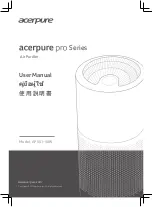
43
System Pre-Start Procedures (Continued)
Figure 4-1
Typical Vacuum Pump Hookup
pressure in the system to “zero” (0 psig) gauge
pressure. Repeat this process two or three times
during evacuation.
Note: It is unlawful to release refrigerant into the
atmosphere. When service procedures require
working with refrigerants, the service technician
must comply with all Federal, State, and local laws.
Refer to the General Service Bulletin MSCU-SB-1
(latest edition).
Standing Vacuum Test
Once 300 microns or less is obtained, close Valve A and
leave valves B and C open. This will allow the vacuum
gauge to read the actual system pressure. Let the system
equalize for approximately 15 minutes. This is referred to as
a “standing vacuum test” where, time versus pressure rise.
The maximum allowable rise over a 15 minute period is 200
microns. If the pressure rise is greater than 200 microns but
levels off to a constant value, excessive moisture is
present. If the pressure steadily continues to rise, a leak is
indicated. Figure 4-2 illustrates three possible results of the
“standing vacuum test”.
If a leak is encounter, repair the system and repeat the
evacuation process until the recommended vacuum is ob-
tained.
Once the system has been evacuated, break the vacuum
with refrigerant, and complete the remaining “Pre-Start Pro-
cedures” before starting the unit.
Figure 4-2
Evacuation Time-vs-Pressure Rise
200
400
600
800
1000
1200
1400
1600
-10
0
10
20
30
40
50
60
70
80
90
TIME IN MINUTES
PR
ESSU
R
E
IN
MIC
R
O
N
S
Continuously increasing pressure
indicates the presence of leaks,
moisture or both.
State of equilibrium indicates the
true amount of moisture left in
the system. It indicates that no
leaks are present, but further
evacuation is required.
State of equilibrium indicates the
true amount of moisture left in
the system. It indicates that no
leaks are present and the
system is properly evacuated.
Initial evacuation pressure
Summary of Contents for RAUC-IOM-15
Page 8: ...8 Figure 3 2A RAUC C80 Unit Dimensional Data Recommended Clearances...
Page 9: ...9 Figure 3 2A Continued RAUC D10 Unit Dimensional Data Recommended Clearances...
Page 10: ...10 Figure 3 2A Continued RAUC D12 Unit Dimensional Data Recommended Clearances...
Page 11: ...11 Figure 3 2B EVPB C80 Evaporator Chiller Dimensions...
Page 12: ...12 Figure 3 2B Continued EVPB D10 Evaporator Chiller Dimensions...
Page 13: ...13 Figure 3 2B Continued EVPB D12 Evaporator Chiller Dimensions...
Page 14: ...14 Figure 3 2B Continued EVPB C80 through D12 Chill Water Pipe Stubout Dimensions...
Page 35: ...35 Installation Continued Field Connection Diagram Notes for all System Control Options...
Page 57: ...57 Figure 5 5 Typical Scroll Compressor Terminal Block System Start Up Continued...
Page 67: ...67...
Page 68: ...68...
















































